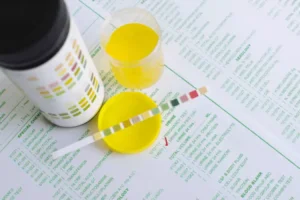
There are many ways to prevent diabetic ketoacidosis and other diabetes complications. They provide some energy to your cells, but too much may cause your blood to become too acidic. Your body makes ketones, but not enough to make your blood too acidic, so ketosis isn’t dangerous. With ketosis, your body has enough insulin and it’s working properly. Laboratory analysis plays a major role in the evaluation of a patient with suspected alcoholic ketoacidosis.

Related MedlinePlus Health Topics
When you don’t have enough insulin, the sugars you eat can’t get out of your blood and into your cells. This makes the sugar build up in your blood, causing high blood sugar. During diabetic ketoacidosis, your blood sugar will be very high and your insulin levels will be low. The interplay of fatty acids, their metabolic pathways, and the precise mechanisms of ketone secretion contribute to the overall picture of alcoholic ketoacidosis. During starvation, there is a decrease in insulin secretion and an increase in the production of counter-regulatory hormones such as glucagon, catecholamines, cortisol, and growth hormone.
DKA Risk Factors
If you have symptoms of alcoholic ketoacidosis, your doctor will perform a physical examination. They will also ask about your health history and alcohol consumption. If your doctor suspects that you’ve developed this condition, they may order additional tests to rule out other possible conditions. After these test results are in, they can confirm the diagnosis. BRENZAVVY is indicated as an adjunct to diet and exercise to improve glycemic control in adults with type 2 diabetes.
Navigating Alcohol Use Disorder With Zinnia Health
- BRENZAVVY is not recommended for use to improve glycemic control in patients with type 1 diabetes mellitus.
- (4) Both conditions share similarities, but medical professionals differentiate them through a comprehensive case assessment.
- Volume DepletionBRENZAVVY can cause intravascular volume contraction which may sometimes manifest as symptomatic hypotension or acute transient changes in creatinine.
- Your body typically produces ketone bodies when breaking down fat for energy, but their levels can rise significantly if you consume a lot of alcohol and don’t eat enough.
- Volume depletion is a strong stimulus to the sympathetic nervous system and is responsible for elevated cortisol and growth hormone levels.
If you chronically abuse alcohol, you probably don’t get as much nutrition as your body needs. Going on a drinking binge when your body is in a malnourished state may cause abdominal pain, nausea, or vomiting. Infection or other illnesses such as pancreatitis can also trigger alcoholic ketoacidosis in people with alcohol use disorder. Alcoholic Ketoacidosis develops primarily as a result of excessive alcohol consumption and inadequate food intake. When individuals indulge in heavy drinking, it leads to a cascade of physiological changes in the body, creating a perfect storm for alcoholic ketosis. Free fatty acids are either oxidized to CO2 or ketone bodies (acetoacetate, hydroxybutyrate, and acetone), or they are esterified to triacylglycerol and phospholipid.
Hypoglycemia with Concomitant Use with Insulin and Insulin Secretagogues Insulin and insulin secretagogues (e.g., sulfonylureas) are known to cause hypoglycemia. BRENZAVVY may increase the risk of hypoglycemia when used in combination with insulin and/or an insulin secretagogue. A lower dose of insulin or insulin secretagogue may be required to minimize the risk of hypoglycemia when used in combination with BRENZAVVY. You can check yourself for ketones at home with a urine sample.

Alcoholic Ketoacidosis Treatment and Diagnosis
With ketosis, you don’t eat many carbohydrates (foods like bread, pasta, or other starches), which usually turn into sugar quickly, so your body starts burning fat to create energy. If your blood sugar is over 240 mg/dL, you should check your ketones using a urine ketone test or a glucometer (blood ketone test) every 4-6 hours. Talk to your doctor if your blood sugar level is outside of your target range. Dehydration and volume constriction directly decrease the ability of the kidneys to excrete ketoacids. Profound dehydration can culminate in circulatory collapse and/or lactic acidosis.
Ketones build up in the blood and eventually spill over into the urine. If you or someone else has symptoms of alcoholic ketoacidosis, seek emergency medical help. Alcoholic ketoacidosis is the buildup of ketones in the blood due to alcohol use. Ketones are a type of acid that form when the body breaks down fat for energy. If you are diagnosed with alcoholic ketoacidosis, your recovery will depend on a number of factors.

Risk factors
Alcoholic ketoacidosis is distinct from diabetic ketoacidosis (DKA) as it doesn’t necessitate diabetes and isn’t synonymous with high blood glucose levels. (4) Both conditions share similarities, but medical professionals differentiate them through a comprehensive case assessment. Triglycerides stored in adipose tissue undergo lipolysis and are released into the circulation as free fatty acids bound ionically to albumin. Free fatty acids are removed by the liver, where they primarily undergo oxidation to hydroxybutyric acid and acetoacetate and subsequently are reesterified to triglyceride. Decreased insulin and elevated glucagon, cortisol, catecholamine, and growth hormone levels can increase the rate of ketogenesis.
These conditions have to be ruled out before a medical professional can diagnose you with alcoholic ketoacidosis. People who alcoholic ketoacidosis drink large quantities of alcohol may not eat regularly. Not eating enough or vomiting can lead to periods of starvation.

- Magnesium and phosphate levels should be measured and repleted if the serum levels are found low.
- Alcoholic ketoacidosis doesn’t occur more often in any particular race or sex.
- It most often occurs in a malnourished person who drinks large amounts of alcohol every day.
It can be helpful to understand the basic guidelines for alcohol consumption so you can determine whether you are drinking above recommended levels and engaging in potentially harmful alcohol use. The resulting increase in the NADH/NAD+ ratio inhibits hepatic gluconeogenesis and elevates the ratio of hydroxybutyric acid to acetoacetic acid. Acetic acid (an acyl group carrier) is linked with coenzyme A (a thiol) to produce Acetyl-CoA. About TheracosBioTheracosBio develops novel therapeutics for diseases with significant societal impact. The mission of TheracosBio is to expand access to new medications for patients with common diseases.

